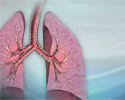COPD flare-ups
COPD exacerbation; Chronic obstructive pulmonary disease exacerbation; Emphysema exacerbation; Chronic bronchitis exacerbation
Chronic obstructive pulmonary disease symptoms can worsen suddenly. You may find it hard to breathe. You may cough or wheeze more or produce more phlegm. You might also feel anxious and have trouble sleeping or doing your daily activities. This problem is called a chronic obstructive pulmonary disease (COPD) exacerbation, or COPD flare-up.
Causes
Certain illnesses, colds, and lung infections from viruses or bacteria can lead to flare-ups. Other causes may include:
- Being around smoke or other pollutants
- Weather changes
- Doing too much activity
- Being run-down
- Feeling stressed or anxious
You can often manage a flare-up right away with medicines and self-care. Work with your health care provider on an action plan for COPD exacerbations so that you know what to do.
Get to know your usual COPD symptoms, sleep patterns, and when you have good or bad days. This can help you learn the difference between your normal COPD symptoms and signs of a flare-up.
Warning Signs of a COPD Flare-up
Signs and symptoms of a COPD flare-up last 2 days or more and are more intense than your usual symptoms. The symptoms get worse and just don't go away. If you have a full-blown exacerbation, you may need to go to the hospital.
Common early signs include:
- Trouble catching your breath
- Noisy, wheezing breathing sounds
- Coughing, sometimes with more mucus than usual or a change in the color of your mucus
Other possible signs of flare-up include:
- Not being able to take deep breaths
- Difficulty sleeping
- Morning headaches
- Abdominal pain
- Anxiety
- Swelling of the ankles or legs
- Gray or pale skin
- Blue or purple lips or nail tips
- Trouble speaking in full sentences
What to Do at the First Sign of a Flare-up
At the first sign of a flare-up:
- Do not panic. You may be able to keep symptoms from getting worse.
- Take medicines as directed for flare-ups. These may include quick-relief inhalers, steroids or antibiotics you take by mouth, anti-anxiety medicines, or medicine through a nebulizer.
- Take antibiotics as directed if your provider prescribes them.
- Use oxygen if prescribed.
- Use pursed lip breathing to save energy, slow your breathing, and help you relax.
- If your symptoms do not get better within 48 hours, or your symptoms keep getting worse, call your provider or go to the hospital.
How to Prevent COPD Flare-ups
If you have COPD:
- Stop smoking and avoid secondhand smoke. Avoiding smoke is the best way to slow down damage to your lungs. Ask your provider about stop-smoking programs and other options, such as nicotine-replacement therapy.
- Take your medicines as directed.
- Ask your provider about pulmonary rehabilitation. This program includes exercise, breathing, and nutrition tips.
- See your provider at least 1 to 2 times per year for check-ups, or more often if directed.
- Use oxygen if your provider recommends it.
Avoid colds and the flu, you should:
- Stay away from people with colds.
- Wash your hands often. Carry hand sanitizer for times when you cannot wash your hands.
- Get all of your recommended vaccines, including a flu shot every year.
- Avoid very cold air or extreme heat and humidity.
- Keep air pollutants, such as fireplace smoke and dust, out of your home.
Live a healthy lifestyle:
- Stay as active as possible. Try short walks and light weight-training. Talk with your provider about ways to get exercise.
- Take frequent breaks throughout the day. Rest between daily activities to save your energy and give your lungs time to recover.
- Eat a healthy diet rich in lean proteins, fish, fruits, and vegetables. Eat several small meals a day.
- Do not drink liquids with meals. This will keep you from feeling too full. But, be sure to drink liquids at other times to keep from getting dehydrated.
When to Call the Doctor
After following your COPD action plan, call your provider if your breathing is still:
- Getting harder
- Faster than before
- Shallow and you cannot get a deep breath
Also call your provider if:
- You need to lean forward when sitting in order to breathe easily
- You are using muscles around your ribs to help you breathe
- You are having headaches more often
- You feel sleepy or confused
- You have a fever
- You are coughing up dark mucus
- Your lips, fingertips, or the skin around your fingernails is blue
- You have chest pain or discomfort
- You cannot speak in full sentences
References
Criner GJ, Bourbeau J, Diekemper RL, et al. Prevention of acute exacerbations of COPD: American College of Chest Physicians and Canadian Thoracic Society guideline. Chest. 2015;147(4):894-942. PMID: 25321320 pubmed.ncbi.nlm.nih.gov/25321320/.
Global Initiative for Chronic Obstructive Lung Disease (GOLD) website. 2021 Global strategy for the diagnosis, management, and prevention of COPD. goldcopd.org/wp-content/uploads/2020/11/GOLD-REPORT-2021-v1.1-25Nov20_WMV.pdf. Accessed December 29, 2021.
Han MK, Lazarus SC. COPD: Diagnosis and management. In: Broaddus VC, King TE, Ernst JD, et al, eds. Murray and Nadel's Textbook of Respiratory Medicine. 7th ed. Philadelphia, PA: Elsevier; 2022:chap 64.
Review Date: 12/6/2021
Reviewed By: Denis Hadjiliadis, MD, MHS, Paul F. Harron Jr. Associate Professor of Medicine, Pulmonary, Allergy, and Critical Care, Perelman School of Medicine, University of Pennsylvania, Philadelphia, PA. Also reviewed by David Zieve, MD, MHA, Medical Director, Brenda Conaway, Editorial Director, and the A.D.A.M. Editorial team.


